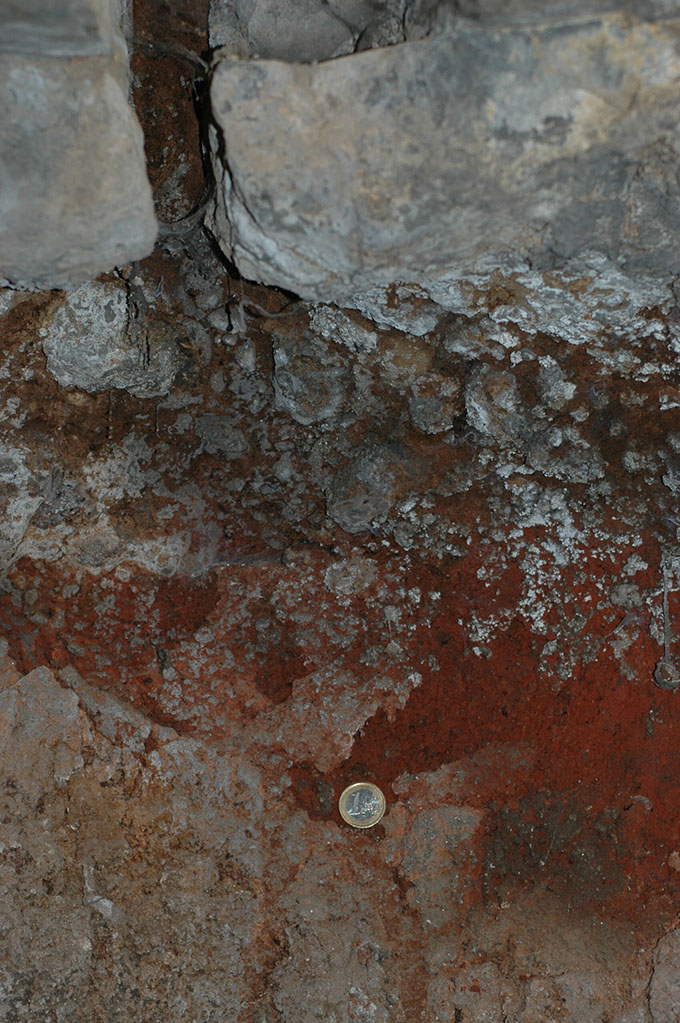Selecting Relevant Education During World of Concrete – Baty’s Top – 10 List
The Concrete Foundations Association has played a significant role in what education opportunities are offered at the World of Concrete for many years. The CFA has consistently brought engaging educational content, with thought leadership by former executive director, Ed Sauter; current executive director, James Baty; such influential thought leaders as engineer, Brent Anderson; and contractors like Mary Wilson and Mike Hancock. Additionally, Baty has been part of the WOC Education Committee for eight years as a representative for the residential concrete industry to ensure there is annual content that is applicable and interesting.

In 2022, there will be many great tracks to consider. Several of these tracks are new to the event and will be delivered by trusted thought leaders. Are you hoping for recommendations on which tracks to take? Consider the following top-10 list from the CFA’s executive director:
Get the complete list of education tracks from https://www.flipsnack.com/BCEB9C99E8C/world-of-concrete-education-2022-program-at-a-glance/full-view.html or dive into the detail as you start the registration process at https://bit.ly/WOC2022A30, using our co-sponsor discount.
- #10 MO101 Motivating Today’s Construction Worker – Brad Humphrey
- #9 MO111 Innovations in Concrete Technology – Michelle Wilson
- #8 TU113 Compressive Strength Failures – Jacob Borgerson
- #7 MO121 Curing Concrete and Why Do We Care – Tyler Ley
- #6 TH110 Steps to a Successful Change Order – Rocky Gean/ Tommy Ruttura
- #5 WE124 Cold Weather: Managing Concrete in Winter – Kim Basham
- #4 TU123 Mix Design Fundamentals – Richard Szecsy
- #3 TH127 Identifying Basic Concrete Surface Problems – Brent Anderson
- #2 MO119 What Is Wrong with My Concrete – Tyler Ley
- #1 TH409 Residential Foundation Technician – James Baty
A Major Win—Motor Carrier Insurance Increase Not Carried in Federal Legislation Proposal
Previously, the Concrete Foundations Association served notice of transportation and infrastructure legislation being developed that would have resulted in a federally mandated increase in minimum liability coverage for all commercial motor vehicles from $750,000 per truck to a proposed $2,000,000. Executive director, James Baty, participated in over two dozen virtual conferences with staff members of key legislators during the first half of this year. The coalition itself tallied more than 150 meetings with staff members from an increasing roster of critical stakeholders and key legislative opponents. Each meeting, on average, had seven to eight coalition representatives who maintained a much broader perspective regarding the actual impact of such an unwarranted increase.
“We became convinced through our research that such an increase would be yet another layer of unrecoverable expenses for an industry already strapped with unparalleled challenges, including workforce and material shortages, increased competition, and pricing pressure from the escalating costs of construction,” stated Baty. “As a coalition, we were continually reinforcing the simple fact that this was an effort brought about by trial lawyers seeking deeper pockets for revenue and leveraging falsified data to key members of the Committee on Transportation and Infrastructure.”
During the week of September 27, 2021, the coalition was informed that their efforts were worthwhile. The proposed insurance increase never got beyond the House, as only the Senate-drafted highway bill was incorporated in the infrastructure package. This means the coalition can officially claim victory. Renewed efforts to pass this legislation in 2022 are very unlikely, due to the supply chain crisis looming amid the midterm elections. Should control of either chamber change thereafter, it is even less likely that Republican leadership would consider such legislation.
Organizations signing on to participate, support and contribute to the Truck Insurance Coalition led by OOIDA and NRMCA included:
- Agricultural Retailers Association
- American Beekeeping Federation
- American Concrete Pavement Association
- American Concrete Pipe Association
- American Concrete Pumping Association
- American Dairy Coalition
- American Farm Bureau Federation
- American Forest and Paper Association
- American Pipeline Contractors Association
- American Sheep Industry Association
- Associated Equipment Distributors
- Colorado Motor Carriers Association
- Concrete Foundations Association
- Concrete Reinforcing Steel Institute
- Consumer Brands Association
- Customized Logistics and Delivery Association
- Distribution Contractors Association
- Energy Marketers of America
- Georgia Motor Trucking Association
- Hawaii Transportation Association
- Kansas Motor Carriers Association
- Livestock Marketing Association
- Maine Motor Transport Association
- Mid-West Truckers Association
- Minnesota Trucking Association
- Missouri Trucking Association
- Motor Carriers of Montana
- Motor Transport Association of Connecticut
- National Aquaculture Association
- National Asphalt Pavement Association
- National Association of Small Trucking Companies
- National Cattlemen’s Beef Association
- National Grain and Feed Association
- National Precast Concrete Association
- National Ready Mixed Concrete Association
- National Stone Sand and Gravel Association
- National Utility Contractors Association
- North American Punjabi Trucking Association
- Nevada Trucking Association
- New Hampshire Motor Transport Association
- New Jersey Motor Truck Association
- New Mexico Trucking Association
- NFIB
- North American Miller’s Association
- North American Punjabi Trucking Association
- North American Renderers Association
- Owner-Operator Independent Drivers Association
- Pet Food Institute
- Port Drivers Association
- Power and Communication Contractors Association
- Precast/Prestressed Concrete Institute
- Rhode Island Trucking Association, Inc.
- South Carolina Trucking Association
- South Dakota Trucking Association
- Southwest Movers Association
- Tennessee Trucking Association
- Texas Trucking Association
- Tilt-Up Concrete Association
- Towing and Recovery Association of America, Inc
- Truck Renting and Leasing Association
- United Dairymen of Arizona
- United Fresh Produce Association
- United States Cattlemen’s Association
- Vermont Truck & Bus Association
- Western States Trucking Association
- Wyoming Trucking Association, Inc
Is Your Safety Manual OSHA Compliant? | A Summary of the Required Topics
By Julia Kunlo, CSP, Vice President
CFA Consulting Member
A written safety manual is often seen as the backbone of a workplace safety program. Documented processes are powerful tools, helping to outline expectations, train employees, bid work, and even avoid legal trouble. What many people do not know, however, is that the Occupational Safety and Health Administration has strict guidelines pertaining to what topics must be included in a written safety program. Are you sure that your company’s safety manual is OSHA compliant?
Authoring a safety manual that meets OSHA standards requires knowledge and research. Lucky for you, we have done the required digging through multiple references so you can quickly understand what your business needs. Based upon your business category (construction, general industry, or both), read below to learn what topics are required and their corresponding OSHA standard.
1. Global Requirements (Regardless of Industry)
Regardless of whether your business is categorized as “construction” or “general industry,” the following topics must be addressed in your manual:
- OSHA recordkeeping (OSHA 29 CFR 1904)
- Hazard communication (OSHA 29 CFR 1926.59 and 1200)
- Emergency action planning (OSHA 29 CFR 1926.35 and 38)
- Fire prevention plan (OSHA 29 CFR 1926.150 and 39)
- First aid (OSHA 29 CFR 1910.151 and 50)
- Lockout/tagout (OSHA 29 CFR 1910.147, 333, and 417)
- Personal protective equipment (OSHA 29 CFR 1910.132 and 1926 Subpart E)
- Hearing conservation (OSHA 29 CFR 1910.95 & 101)
- Crane/hoisting inspection program (OSHA 29 CFR 1910.179, 184, 251, and 552)
- Respiratory protection program (OSHA 29 CFR 1910.134 and 103)
- Powered industrial truck operator training (OSHA 29 CFR 1910.178 and 602[d])
2. Construction Industry Requirements
If your business is categorized as construction, then OSHA 29 CFR 1926 applies. In addition to the global requirements, the following topics must be address in your manual:
- General safety and health provisions (OSHA 29 CFR 1926.20)
- Trenching and excavations (OSHA 29 CFR 1926.651 and 652)
- Fall protection (OSHA 29 CFR 1926 Subpart M)
- Safety training and education (OSHA 29 CFR 1926.21)
3. General Industry Requirements
If your business is categorized as general industry, then OSHA 29 CFR 1910 applies. In addition to the global requirements, the following topics must be address in your manual:
- Electrical safety-related work practices (OSHA 29 CFR 1910.331, 332, 333, 334, 335, and 399)
- Bloodborne pathogen exposure (OSHA 29 CFR 1910.1030)
- Confined space entry (OSHA 29 CFR 1910.146)
- Machine guarding (OSHA 29 CFR 1910 Subpart O)
- Hot work program (OSHA 29 CFR 1910.106, 119, and 252)
- Laboratory chemical safety (OSHA 29 CFR 1910.1450)
- Spill response plans (OSHA 29 CFR 1910.120)
When building a written safety manual, it is important that companies understand the minimum requirements outlined by OSHA. This understanding will help to create a program that is equipped to protect businesses from legal or regulatory trouble. It is equally as important to build a manual that can be used as a practical and helpful tool for your business, training your team on how you expect them to perform safely in the field. Consider adding additional best-in-class procedures to your manual (such as information on defensive driving, heat/cold stress, job hazard analysis, etc.) to build a written program that is truly top level. If you need assistance with auditing your current manual or making improvements, the experts at ESR are ready and available to help. We offer free consultations and will develop complimentary improvement plans.
Roman Noblewoman’s Tomb Reveals Secrets of Ancient Concrete Resilience
By Paul Gabrielsen
science writer, University Marketing & Communications
Over time, concrete cracks and crumbles. Well, most concrete cracks and crumbles. Structures built in ancient Rome are still standing, exhibiting remarkable durability despite conditions that would devastate modern concrete.
One of these structures is the large cylindrical tomb of first-century noblewoman Caecilia Metella. New research shows that the quality of the concrete of her tomb may exceed that of her male contemporaries’ monuments because of the volcanic aggregate the builders chose and the unusual chemical interactions with rain and groundwater with that aggregate over two millennia.
“The construction of this very innovative and robust monument and landmark on the Via Appia Antica indicates that she was held in high respect,” says Marie Jackson, research associate professor of geology and geophysics at the University of Utah, “and the concrete fabric 2,050 years later reflects a strong and resilient presence.”
The research is published in the Journal of the American Ceramic Society and is funded in part by the U.S. Department of Energy ARPA-e “Extreme Durability of Cementitious Materials” program.
Who was Caecilia Metella?
The tomb of Caecilia Metella is a landmark on the Via Appia Antica, an ancient Roman road also known as the Appian Way. It consists of a drum-shaped tower that sits on a square base, in total about 70 feet (21 m) tall and 100 feet (29 m) in diameter. Built about 30 BCE, at the transformation of the Roman Republic to the Roman Empire, led by Emperor Augustus, in 27 BCE, the tomb is considered one of the best-preserved monuments on the Appian Way (a castle attached to the tomb was built in the 14th century).
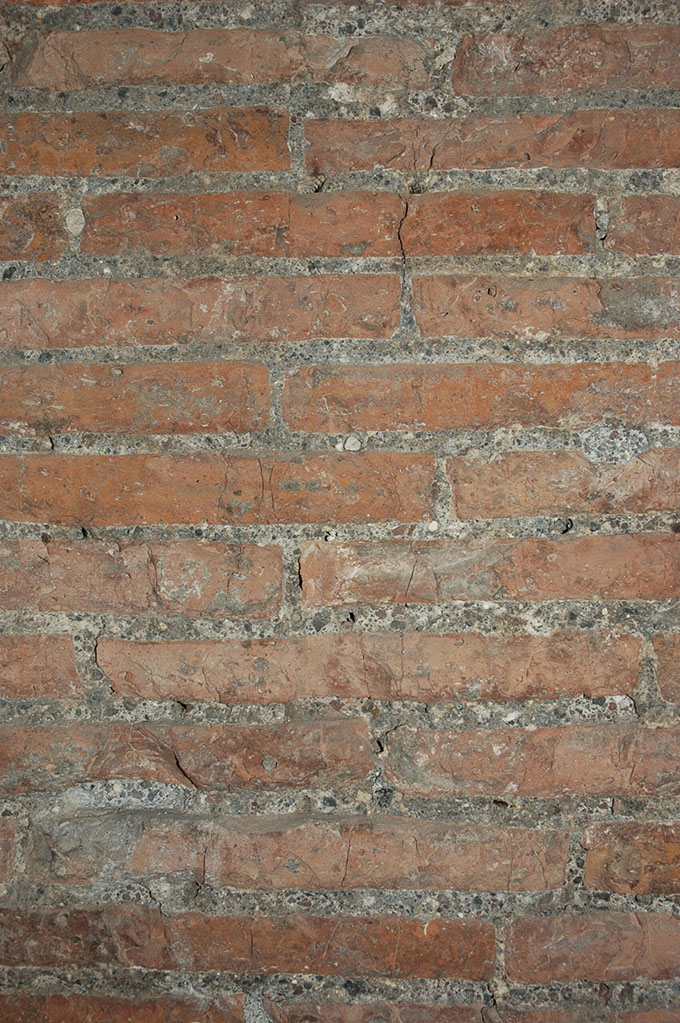
Caecilia herself was a member of a wealthy family, the daughter of a Roman consul. She married into the family of Marcus Licinius Crassus, a Roman general and statesman who formed a famous triumvirate alliance with Julius Caesar and Pompey.
Not much more is known about Caecilia’s life, but the enduring magnitude of her tomb has caught the attention of visitors for centuries, including Lord Byron who wrote of the tomb in “Childe Harold’s Pilgrimage” in the early 1800s. After describing the fortress-like structure, Byron asks:
“What was this tower of strength? within its cave
What treasure lay so lock’d, so hid?—A woman’s grave.”
Jackson visited the tomb in 2006 with archaeologist Dottoressa Lisa Gianmichele and with a permit from the Soprintendenza Archeologia di Roma to collect small samples of the mortar for analysis.
“It was a very warm day in June,” she says, “yet when we descended the steps to the sepulchral corridor the air became very cool and moist.” She notes the compact, cohesive, nearly perfectly preserved brick masonry walls and the nearly water-saturated volcanic rock outcrop in the sub-structure.
“The atmosphere was very tranquil,” she adds, “except for the fluttering of pigeons in the open center of the circular structure.”
What is Roman concrete?
Before diving into the particulars, let’s get oriented to the terminology of concrete. Walk along most any sidewalk and you’ll see that concrete is made of an aggregate (rock sands and gravels) and a cement binder. The cement in a modern sidewalk is likely Portland cement, produced by heating limestone and clay minerals in a kiln to form clinker, grinding the clinker and adding a small amount of gypsum.
The tomb is an example of the refined technologies of concrete construction in late Republican Rome that contain no cement. The technologies were described by the architect Vitruvius during the period when the tomb of Caecilia Metella was under construction. Building thick walls of coarse brick or volcanic rock aggregate bound with mortar made with hydrated lime and volcanic tephra (porous fragments of glass and crystals from explosive eruptions), would result in structures that “over a long passage of time do not fall into ruins.”
Vitruvius’ words are proven true by the many Roman structures standing today, including Markets of Trajan (built between 100 and 110 CE, more than a century after the tomb) and marine structures like piers and breakwaters, which Jackson and her colleagues have also studied.
What the ancient Romans couldn’t have known, though, is how crystals of the mineral leucite, which is rich in potassium, in the volcanic tephra aggregate would dissolve over time to beneficially remodel and reorganize the cohesion of the concrete.
To understand the mineral structure of the concrete, Jackson teamed up with researchers Linda Seymour and Admir Masic from the Massachusetts Institute of Technology and Nobumichi Tamura at the Lawrence Berkeley National Laboratory. They delved into the microstructure of the concrete with an array of powerful scientific tools.
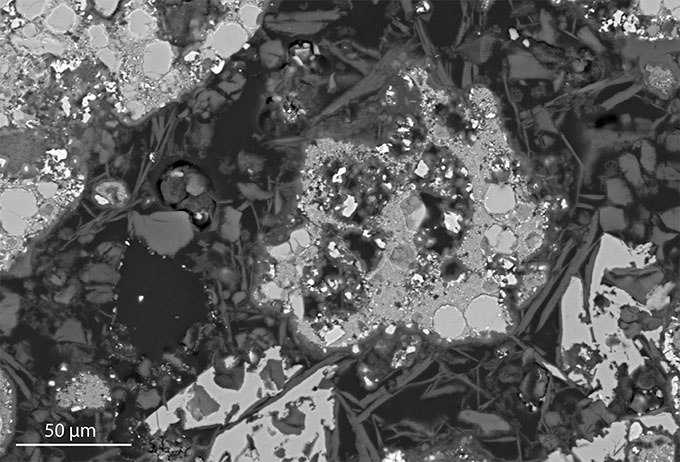
Scanning electron microscopy image of the tomb mortar. The C-A-S-H binding phase appears as gray while the volcanic scoriae (and leucite crystals) appear as light gray.
“Samples such as ancient mortar are highly heterogeneous and complex, made of a mixture of different crystalline phases with grain sizes ranging from a few micrometers down to a few nanometers,” says Tamura, who conducted analyses using the Advanced Light Source beamline 12.3.2. To identify the different minerals in the sample, as well as their orientation, he says, you need an instrument like the microdiffraction beamline at the Advanced Light Source that produces a “micron size, extremely bright and energetic pencil X-ray beam that can penetrate through the entire thickness of the samples, making it a perfect tool for such a study.”
Seymour, who participated in this study as a Ph.D. student at MIT and is now a project consultant with engineering firm Simpson, Gumpertz & Heger, conducted additional analyses on the samples.
“Each of the tools that we used added a clue to the processes in the mortar,” she says. Scanning electron microscopy showed the micro-structures of mortar building blocks at the micron scale. Energy-dispersive X-ray spectrometry showed the elements comprising each of those building blocks. “This information allows us to explore different areas in the mortar quickly, and we could pick out building blocks related to our questions,” she says. The trick, she adds, is to precisely hit the same building block target with each instrument when that target is only about the width of a hair.
Why is the concrete at Caecilia’s tomb so unique?
In the thick concrete walls of Caecilia Metella’s tomb, a mortar that contains volcanic tephra from the nearby Pozzolane Rosse pyroclastic flow (a dense mass of hot tephra and gases ejected explosively from the nearby Alban Hills volcano) binds large chunks of brick and lava aggregate. It is much the same mortar used in the walls of the Markets of Trajan 120 years later.
In previous analysis of the Markets of Trajan mortar, Jackson, Tamura and their colleagues explored the “glue” of the mortar, a building block called the C-A-S-H binding phase (calcium-aluminum-silicate-hydrate), along with a mineral called strätlingite. The strätlingite crystals block the propagation of microcracks in the mortar, preventing them from linking together and fracturing the concrete structure.
But the tephra the Romans used for the Caecilia Metella mortar was more abundant in potassium-rich leucite. Centuries of rainwater and groundwater percolating through the tomb’s walls dissolved the leucite and released the potassium into the mortar. In modern concrete, such a flood of potassium would create expansive gels that would cause microcracking and eventual spalling and deterioration of the structure.
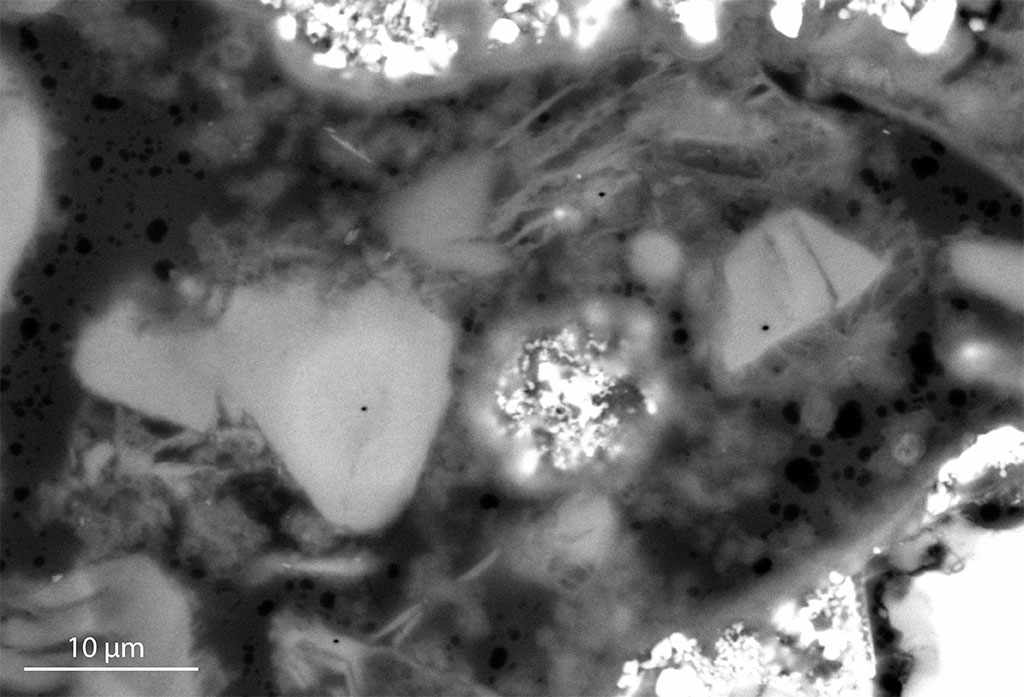
Scanning electron microscope image of the tomb mortar. The intact and wispy C-A-S-H features appear as gray, while the volcanic aggregate appears as white.
In the tomb, however, the potassium dissolved and reconfigured the C-A-S-H binding phase. Seymour says that X-ray microdiffraction and Raman spectroscopy techniques allowed them to explore how the mortar had changed. “We saw C-A-S-H domains that were intact after 2,050 years and some that were splitting, wispy or otherwise different in morphology,” she says. X-ray microdiffraction, in particular, allowed an analysis of the wispy domains down to their atomic structure. “We see that the wispy domains are taking on a nano-crystalline nature,” she says.
The remodeled domains “evidently create robust components of cohesion in the concrete,” says Jackson. In these structures, unlike in the Markets of Trajan, there’s much less strätlingite formed.
Stefano Roascio, the archaeologist in charge of the tomb, notes that the study has a great deal of relevance to understanding other ancient and historic concrete structures that use Pozzolane Rosse aggregate.
Admir Masic, associate professor of civil and environmental engineering at MIT, says that the interface between the aggregates and the mortar of any concrete is fundamental to the structure’s durability. In modern concrete, he says, the alkali-silica reactions that form expansive gels may compromise the interfaces of even the most hardened concrete.
“It turns out that the interfacial zones in the ancient Roman concrete of the tomb of Caecilia Metella are constantly evolving through long-term remodeling,” he says. “These remodeling processes reinforce interfacial zones and potentially contribute to improved mechanical performance and resistance to failure of the ancient material.”
Can we recreate that effect today?
Jackson and her colleagues are working to replicate some of the Romans’ successes in modern concretes, specifically in a U.S. Department of Energy ARPA-e project to encourage similar beneficially reactive aggregates in concretes that use engineered cellular magmatics in place of the tephra of the ancient Roman structures. The objective, according to ARPA-e, is that a Roman-like concrete could reduce the energy emissions of concrete production and installation by 85% and improve the 50-year lifespan of modern marine concretes four-fold.
“Focusing on designing modern concretes with constantly reinforcing interfacial zones might provide us with yet another strategy to improve the durability of modern construction materials,” Masic says. “Doing this through the integration of time-proven ‘Roman wisdom’ provides a sustainable strategy that could improve the longevity of our modern solutions by orders of magnitude.”
Links:
1. Journal of the American Ceramic Society – https://doi.org/10.1111/jace.18133
2. Full research study – https://doi.org/10.1111/jace.18133
Cold Weather’s a-Comin’
Practical Applications of CFA Cold-Weather Research
Every year since 2004, contractors, homeowners, builders, and especially members have contacted the Concrete Foundations Association headquarters looking for information about the performance of and best practices for cast-in-place concrete during the winter season. In advance of the approaching winter, this article offers practical advice supported by the significant research the CFA produced from 2001-04 and some responses to common inquiries. Several additional articles covering more of the basics of cold-weather concrete can be found at www.concretefactsmagazine.com.
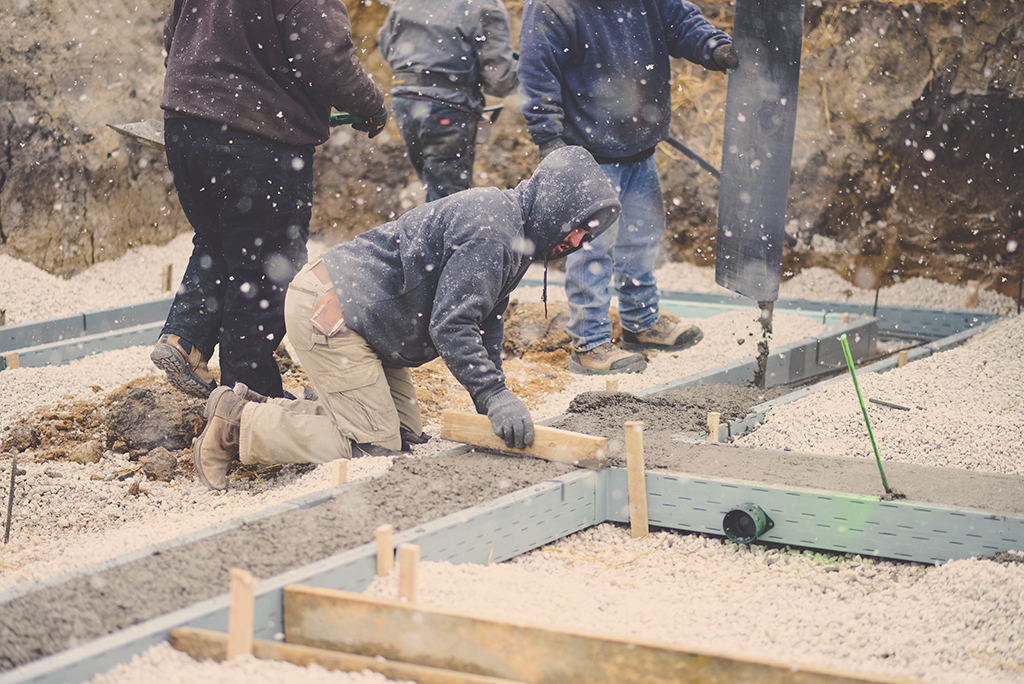
It seems obvious that, if properly managed, placing concrete during the winter is feasible, even common. Despite decades of experience and countless markets that undergo moderate to severe cold weather, each year the transition from autumn to winter brings a new sense of concern and finds many in the industry seeking either advice or advocacy. It seems that each market operates with a different concept of what cold actually means. We never stop to think whether the concrete itself knows the weather has turned cold; the reality is that the dropping temperature induces a slowing effect on concrete maturity.
Concrete maturity, the hardening and strengthening from a highly viscous mix into a rock-like structural material, requires a balance of time, temperature, and moisture. Take any course on concrete performance (including the CFA’s preparation course for becoming an ACI/CFA residential foundation technician) and you will come away with a much deeper understanding of the decisions that influence this critical relationship. Adjusting, eliminating, or increasing one factor will certainly impact the result and necessitate adjustment in the other two legs of the “concrete stool” to achieve the targeted result. Therefore, when the air temperature begins to drop, those with rudimentary to moderate knowledge of this tenuous relationship immediately become concerned that poor concrete will result.
Two decades ago, there was a common misconception that hydration, the chemical process initiated when water comes into contact with cementitious material, ceases at 40 degrees Fahrenheit. More recently, there is an assumption that an air-temperature of 32 F is sufficient to “freeze” the concrete. While a large portion of the concrete industry operates outside these fictional beliefs, proving they are false may be a challenge. Today, backed by research, updated technical guide documents, and codified prescriptive standards, there is a recognized platform for professional contractors to prove year-round quality and anticipate the decisions necessary to achieve consistent results. While the research report is available for purchase by anyone interested, association members have enhanced access and the opportunity to leverage the research to produce cold-weather action plans.
The first goal of a cold-weather action plan is to determine the targeted performance. This will depend on the type of concrete project and the concrete placement location. For instance, the maturity time for concrete on an elevated deck in the middle of December will be dramatically different from a slab-on-ground, and more different still from a vertical foundation wall in an excavation. However, with the relevant knowledge regarding decisions to make and protection measures to take, these concrete maturation factors can be manipulated to achieve the targeted performance. Focusing on the concrete foundation industry, the main items that affect the targeted performance are:
- When do the forms need to be removed (or when can they be removed)?
- When will the foundation receive backfill?
- When will the foundation be built on?
- What is the exposure plan for the finished wall?
- What are the projected temperatures during these time periods?
With these primary questions answered, a residential concrete contractor can swiftly make good decisions for cold-weather performance, including decisions about mix design, enclosure, and, when necessary from extreme conditions, provisional heating. The document most often cited for authority on cold weather is ACI 306,1 which states in its introduction:
The objectives of cold weather concreting practices are to prevent damage to concrete due to freezing at early ages, ensure that the concrete develops the required strength for safe removal of forms, maintain curing conditions that foster normal strength development, limit rapid temperature changes, and provide protection consistent with the intended serviceability of the structure.
Since ACI 306 is a guide and not a document of mandatory requirements, there is a lot of variation in what are determined to be the best construction practices. With the ACI 306 objectives in mind, the CFA’s research report2 provides evidence for facts about concrete behavior to help apply these objectives to foundation walls:
- Early-age freeze damage does not occur after a concrete strength of 500 psi.
- Final set is achieved at or below 500 psi.
- Form removal is safe once the final set strength has been reached.
- Strength gain will continue above concrete temperatures of 27 F.
- Strength gain will resume, even if it ceased during a freezing cycle.
These facts about concrete construction, proven through research, should form the basis of any approach taken during cold weather. There are still many decisions to make and options to pursue, but these fundamentals help explain how successful cold-weather concrete performance is much more than possible.
Protection From Freezing
Contractors with less experience often bring up two major concerns when discussing concrete freezing. First is the obvious problem: structural failure. This is most often a warranted concern in elevated or suspended structural applications, but it is never an issue for ground-supported or lightly loaded concrete applications (like a residential foundation).
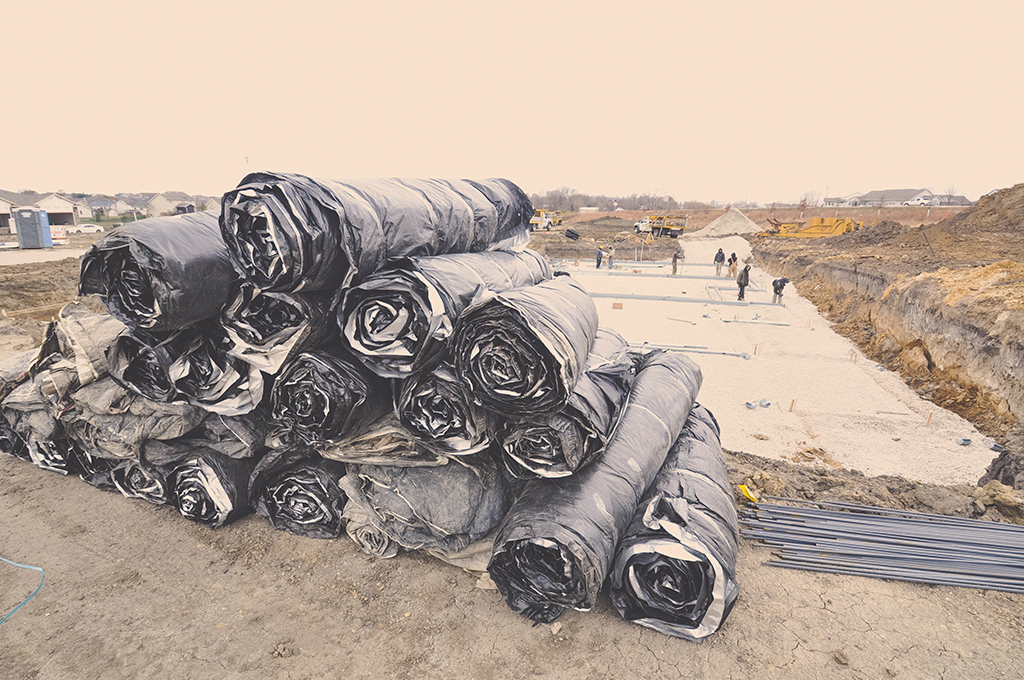
Though less dramatic, the second concern is more common or probable: surface durability. As the concrete temperature drops below the freezing point of water, ice lenses begin to form in the free water along the surface layers. These ice lenses interrupt the normal hydration process, preventing some of the cementitious particles in the surface paste from developing sufficient strength to remain attached to the rest of the growing concrete volume. Therefore, when temperatures permit thawing or when multiple freeze/thaw cycles occur, the concrete surface is not strong enough to resist the movement and the surface delaminates either as spalling or dusting. Surface deterioration can be both an aesthetic and a durability concern.
ACI 3323 says that concrete compressive strength must achieve 500 psi before being permitted to freeze. At 500 psi, research (like that from the CFA) has proven that the concrete has reached its final set, meaning free water is no longer present and therefore ice lenses cannot form. ACI documents, including 332 and 306, suggest preventing concrete from experiencing a second freeze until it has reached its design strength or 3,500 psi, whichever is lower.
The CFA research shows the various mixes that achieved 500 psi at different intervals under cold to frozen conditions, allowing contractors to select a mix based on the time and severity of temperature exposure, along with whether or not there are other protective measures.
Removal of Forms
For the concrete contractor, productivity is the main motivation for removing forms. Often limited in the amount of form sets, contractors like to strip forms so they can move quickly to the next job. This preference puts pressure on decisions involving timing. During the peak construction season, a basic residential foundation might be seen as a three-day process, once the excavation is completed. Day 1: Form and place footing concrete. Day 2: Set wall forms and place concrete. Day 3: Strip forms and prepare wall for backfill. While aggressive, many contractors have a mindset similar to this when planning how to move form sets across their projects.
The issue of “when” is a much bigger question as air temperatures drop and concern for strength gain is greater. ACI 347R4 states in Table 5.7.2.3 that, in the absence of a specified minimum strength to be obtained before form removal, it is generally assumed that formwork for walls can be stripped after 12 hours.
It is also important to ensure concrete strength is obtained during a cold-weather application so that strength can continue developing and the project can proceed. As previously stated, CFA research identifies 500 psi as the point when final set is reached. ACI’s concrete terminology defines “final setting” as:
a degree of stiffening of a cementitious mixture greater than initial setting, generally stated as an empirical value indicating the time required for the cementitious mixture to stiffen sufficiently to resist, to an established degree, the penetration of a weighted test device.
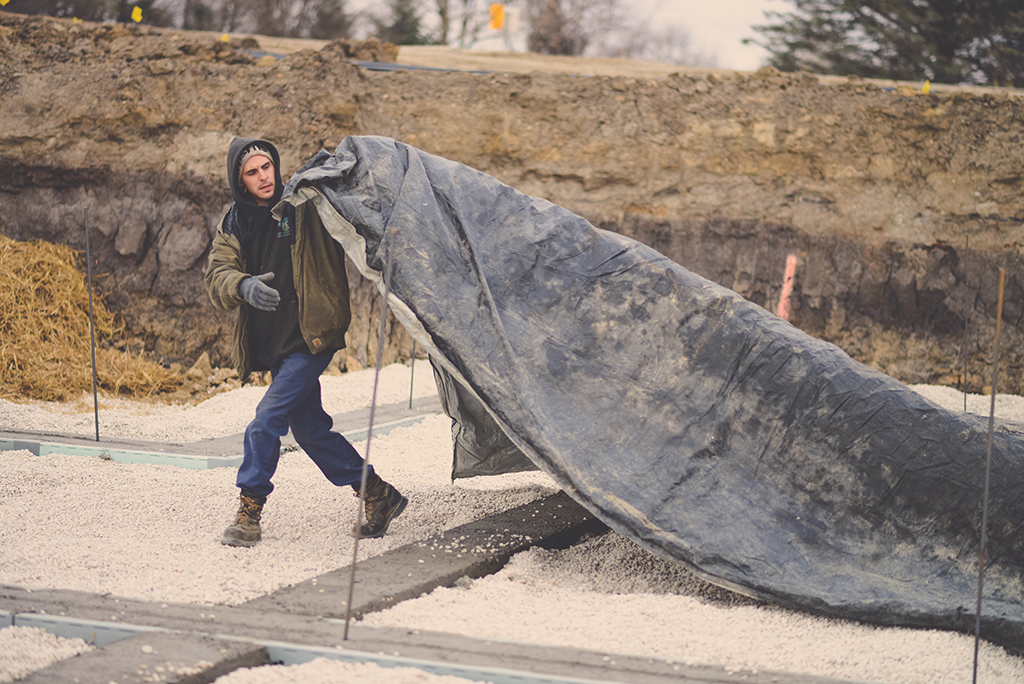
“Final set” is also widely recognized as the state at which concrete is self-supporting—that is, it will not become deformed by gravity acting on its volume. Once at or past 500 psi, forms are no longer necessary for containing the concrete foundation’s form.
Minimum strength is sometimes specified for form removal prior to beginning work on a concrete element, but this is almost always related to a structural concrete element that will take a large load or will be required to support its own weight along with applied loads across an unsupported span. Again, this does not pertain to the relatively shorter walls of residential foundations and slabs-on-ground. Regardless, a mix design can be selected to easily target the specified strength at virtually any duration. Likewise, an existing mix can be assessed to determine the strength at any given interval.
Achieving Strength Gain in Winter
CFA research offers many different mix designs—44, in fact. Unfortunately, the amount of information can deter the casual contractor from realizing its utility. Beginning with lab-cured cylinders to produce a total of more than 800 specimens, predictive maturity curves were compared to compressive breaks at six common intervals between 24 hours and 28 days. This correlated data has proven concrete’s behavior in sub-freezing air temperatures and attests to the reliability of predicting behavior based on the impact of air temperature on concrete temperature.
Targeting a more specific correlation to foundation wall conditions, a total of six mix designs were chosen from the lab research for the field. Walls were cast and forms were pulled 24 hours later. The wall specimens experienced 20 days of sub-freezing ambient air until the temperatures finally lifted above freezing at the end of the month. Along the way, field-cured cylinders and cores were tested over the same time intervals as the lab in order to further show the confidence in predictive maturity methods. Additionally, blankets for short-term protection were provided on one set of wall samples during the first critical 24-hour period and then removed for the remainder of the test period.
All full-scale wall specimens achieved the minimum protection strength of 500 psi before the concrete temperature dropped below freezing and hydration ceased. All but the leanest mix reached strengths far higher than this. Later, petrography was added to the concrete core specimens to determine the impact of freezing conditions. In line with the concrete reaching the minimum strength, the samples did not have any remarkable signs of weakened durability.
Based on this research and the continued efforts of ACI committees 306 and 332, the CFA frequently analyzes mixes for cold-weather placements for the benefit of member contractors, giving recommendations for alterations to mix specifications for key temperature ranges and short-term protective measures to use with leaner mixes.
A contractor may ask for the performance comparison of a 4,000-psi mix using Type I cement and a mid-range water reducer. This can quickly be compared to the mixes in the research to identify the length of time it takes to reach 500 psi. Knowing this duration, the impact of air temperature on a concrete foundation wall volume temperature can be used to qualify the mix for a temperature range of perhaps 20 F and higher. Should the anticipated temperatures drop to be between 10 and 20 F, alterations of this mix might include switching to a Type III cement, and for a range from 0 to 10 F, the use of an accelerator might be the better protection measure. Blankets capping the top of the wall for the first 24 hours ensures the consistency of protection, and the wall forms may likely be removed the next day.
Emulating or directly correlating any mix produced, delivered, and protected with the practice recommendations found in the CFA’s cold-weather research report has increased quality during an otherwise challenging time of the year. The CFA’s advocacy to communicate these researched recommendations has led to numerous case studies of successful and improved recommended practices for both contractors and concrete suppliers.
A tech note made available to the public from the Toolbox found at www.cfaconcretepros.org offers summary information and communicates several of the most influential best practices. To access the complete research, contact the headquarters of the Concrete Foundations Association.
References
- “ACI 306-16: Guide to Cold Weather Concreting,” American Concrete Institute. 38800 Country Club Drive, Farmington Hills, MI 48331. | Phone: 248-848-3700 | www.concrete.org
- “Casting Residential Foundation Walls in Cold Weather,” Concrete Foundations Association. PO Box 204, Mount Vernon, IA 52314. | Phone: 319-895-6940 | www.cfaconcretepros.org
- “ACI 332-14: Residential Code Requirements for Structural Concrete and Commentary,” American Concrete Institute. 38800 Country Club Drive, Farmington Hills, MI 48331. | Phone: 248-848-3700 | www.concrete.org
- “ACI 347-14: Guide to Formwork for Concrete,” American Concrete Institute. 38800 Country Club Drive, Farmington Hills, MI 48331. | Phone: 248-848-3700 | www.concrete.org
2021 CFA PROFESSIONAL AWARDS
Recognizing Experience, Commitment, and Perseverance
Associations are networks of organizations and individuals with common goals, themes, and interests. Each year, associations spend billions of dollars on conventions, conferences, convenient networking systems, resources, and programs designed, often, to support the idealistic purpose of bettering their industries. However, perhaps the more realistic or actual impact is the betterment of those involved.
Since the early 1990s, the Concrete Foundations Association, established in 1974, has been recognizing leadership and industry contributions. The pinnacle recognitions are the Robert D. Sawyer Award and the Lifetime Achievement Award, which deliver the combination of appreciation and honor to individuals persevering and leading through decades of industry and association involvement. In the late 1990s, the annual recognition of a leading contractor voice was set in motion with the Contractor of the Year award. Then, in 2015, a new series of awards was developed to further recognize the breadth of the association as we experienced growth and increasing participation. In this issue, we introduce you to some of the latest leaders who are impacting our industry. What do they all have in common? They do not think of themselves as leaders, but rather as just doing their part to contribute, finding new ways to evolve their companies by leveraging their association platform.
_______________________________________________________________________________________________________________________
It Only Takes a Spark to Start a Flame
KICK-STARTER MEMBER OF THE YEAR
CHAPIN CONCRETE CONTRACTORS INC.
180 Murray Lindler Rd. | Chapin, SC 29036 | www.chapinconcrete.com
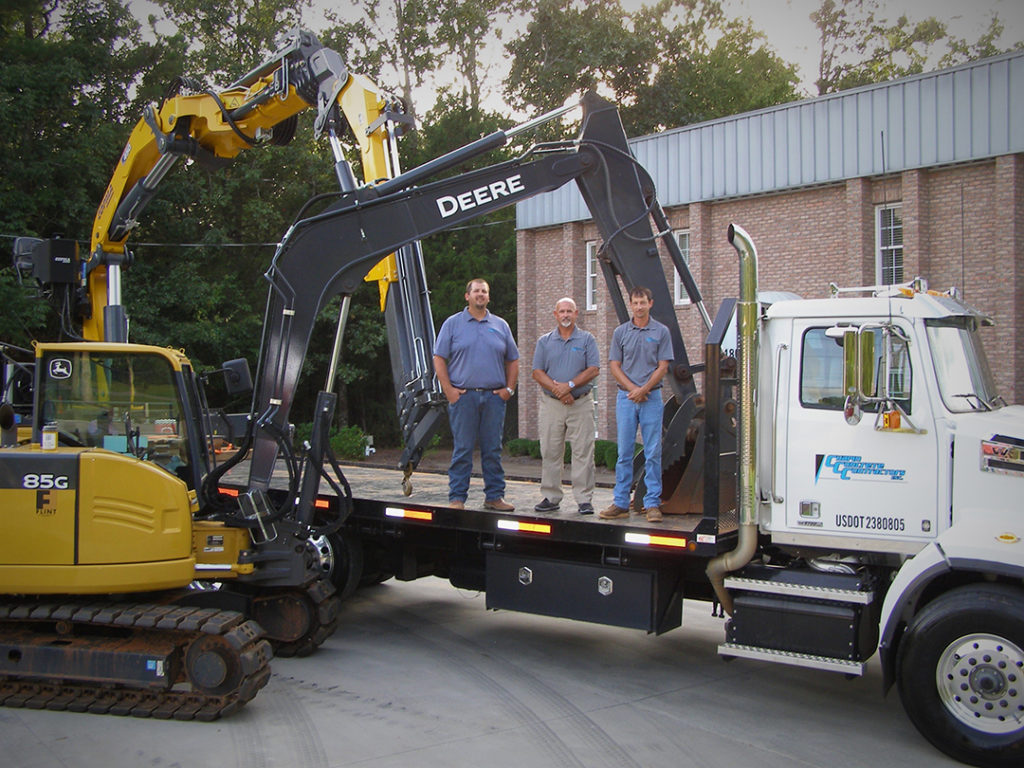
The Kick-Starter Member Award recognizes a member of the association who is maximizing their networking presence within the first three years of joining the CFA. While there are many ways of participating and experiencing the benefits of the CFA, companies who vigorously use the benefit of networking are nominated to the Board of Directors for recognition. This year’s Kick-Starter company burst onto the scene with the association in 2019. Chapin Concrete became a new brand to the southeast region of the U.S. when the leadership of Ashmore Concrete Contractors made the decision to cease general concrete operations and to specialize in concrete pumping. The father and son duo, Charlie and Chris Marra, then stepped away to form their new company, and they immediately began growing, quickly expanding throughout the entire state of South Carolina.
As growth continued, Chris began seeking out resources that could aid them, principally looking for a network of colleagues who would challenge them to be the best company possible. In 2019, company leaders were introduced to the Concrete Foundations Association at the World of Concrete, and they made the decision to join. Immediately upon establishing connection with the CFA network, Chris and the staff at Chapin went to work on identifying the steps to becoming a CFA Certified Foundation Company. These steps included attaining an ACI Certified Foundation Technician credential during the 2020 World of Concrete and (later) completing the conditional steps for the company. Chapin Concrete Contractors has since participated in both the virtual Concrete Foundations Convention and the virtual Foundations Academy, held online during the COVID pandemic.
“Receiving the Kick-Starter of the year award is flattering and an honor,” Chris Marra said. “We have been working diligently over the last two years to get involved with our industry and have a presence not only in our area, but with our peers around the country. This award is validation of our hard work.”
With the change of venue for #CFACON finalized to Charleston, SC, this year, Chapin Concrete offered to serve as the event’s host contractor and to use their local experience to help maximize attendees’ enjoyment of the area. “CFACON 21 was our very first convention. We really enjoyed the camaraderie with everyone in attendance. Our biggest takeaway was being able to sit in and hear how other professionals operate their businesses. We do not have many poured-wall contractors in our area, so having the chance to listen to our peers from different areas was extremely beneficial.”
Doug Herbert, president of Herbert Construction (of Marietta, Georgia) and the president of the CFA board of directors said, “The aggressiveness of Chapin Concrete to leverage membership and company certification as they step into the marketplace to make a name for their standalone presence speaks volumes to the type of leadership they have.” He added, “I can only imagine the challenge faced by the climb to elevate a new brand from the shadows of an existing recognized leader. The fact that Chapin recognized the impact to their brand offered by affiliation with the CFA honors the integrity of our members. Their immediate engagement with our programs and resources evidences the intentional advancement we offer.”
When asked what this award brings about for the company, Marra responded, “I feel that we have set the bar high after receiving this award. The challenge I see for our company is to use this award as a steppingstone to be a voice in our industry, not only in our local markets, but also regionally and nationally. The CFA provides the perfect avenue for us to achieve this.”
_______________________________________________________________________________________________________________________
If You Build It…They Will Apply
MOST INNOVATIVE CONTRACTOR OF THE YEAR
HOTTMANN CONSTRUCTION COMPANY INC.
6156 Darlin Dr. | Dane, WI 53529 | www.hottmannconstruction.com
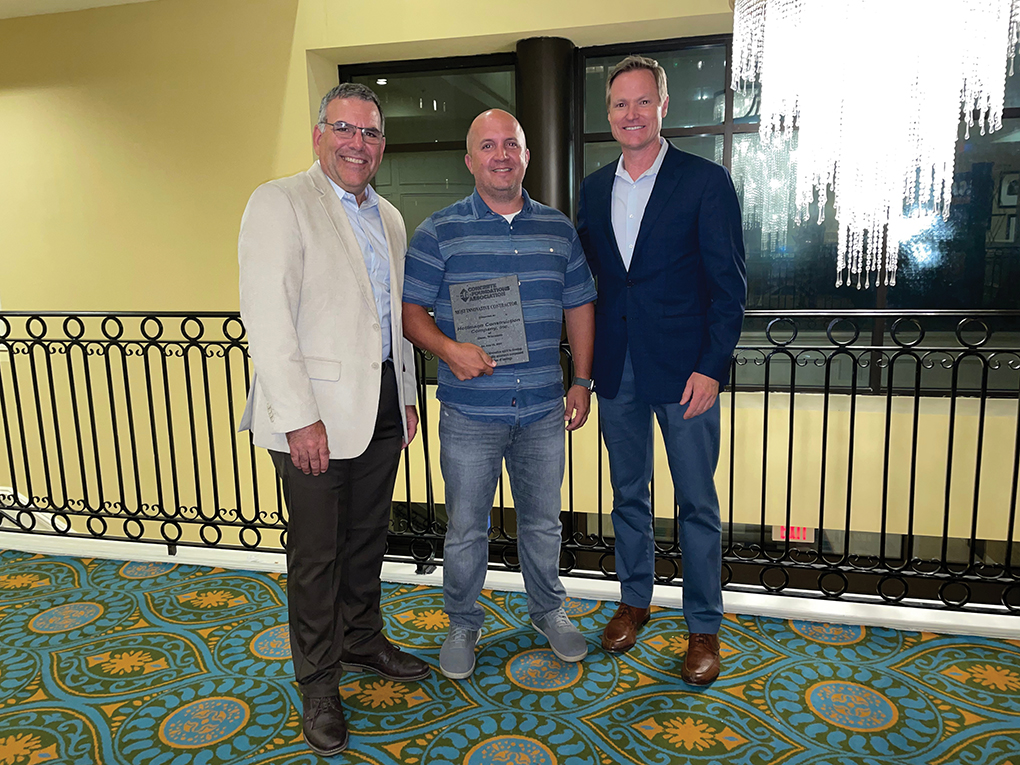
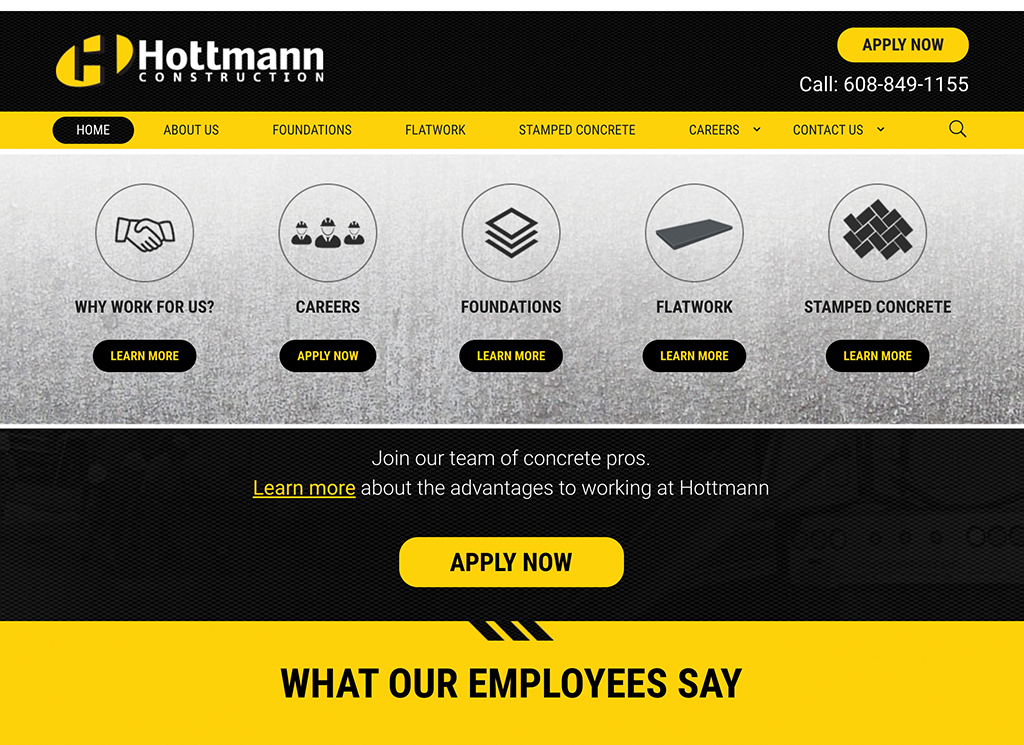
The Most Innovative Contractor Award seeks to recognize the well-known fact that innovation often takes place within contracting businesses themselves, sometimes ahead of manufacturing solutions. Innovation may be product- or system-related, as seen by innovations from numerous past recipients. Innovation may also come in the form of a fresh look at a strategic hurdle facing the company or industry.
Every company would agree that we currently face the largest workforce crisis in the history of the association and every business in the construction industry. In addition, there is an inordinate amount of challenges faced daily for running construction companies during a pandemic. The stresses of the market for material shortages and business volume are in direct opposition. Still, of top importance today may very well be how companies market themselves in the face of the largest pressure: the workforce crisis.
Hottmann Construction has stepped out as an example for all to consider, marketing themselves as a destination employer. While most companies continue to view their website as a primary resource for growing business, Hottmann has transformed their message to that of one meant for the employees they seek and of being a reputable employer. They organized their website to show information describing why their company is a great place to work, which signifies both to potential hires and to companies looking to engage their services that the teams at Hottmann Construction complete great work. The result has been a measured increase in attraction to both audiences, the marketplace and customers.
“We are always talking about new ways to attract, train, and retain employees,” said Ken Kurszewski, president for Hottmann. “In many companies, there is typically a lot of pressure put on those who are interviewing and hiring. Here at Hottmann, we recognize it is the responsibility of the entire team, from owners to field laborers, that are responsible for retention and impressions on new and existing employees.”
Innovation happens at numerous levels. In a time when business is defined less by materials and technologies and more by sustaining power and energy, it seems right to recognize innovative ways to speak into and attract the potential workforce.
“I grew up in the environment of innovation within this association,” states the CFA board president, Doug Herbert. “Many of the services, tips, and strategies we now use within our company were learned from our peers and colleagues, discussed at numerous conventions. In turn, new technologies that we have found over the years have influenced other members time and time again. Innovation is critical to the success of the cast-in-place concrete foundation contractor, and Hottmann has given us new inspiration as to where we can find it.”
_______________________________________________________________________________________________________________________
The Best Road to Business Is Doing Your Part
NATIONAL ASSOCIATE MEMBER OF THE YEAR
CHRIS WARD | WESTERN FORMS
6200 Equitable Rd. | Kansas City, MO 64120 | www.westernforms.com
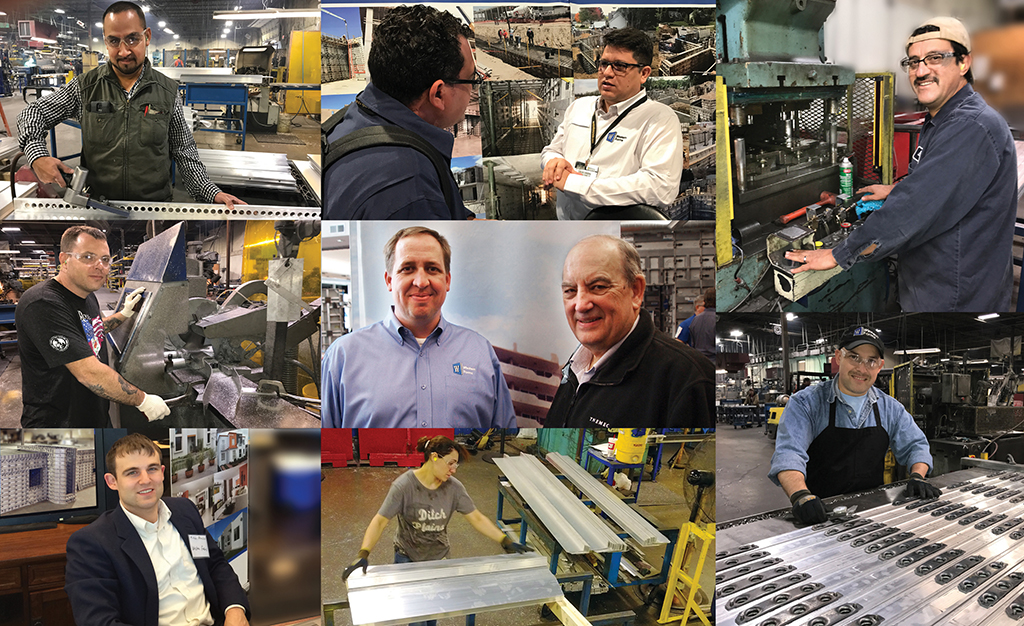
What is often overlooked, or perhaps misunderstood, within the resource and networking focus of the CFA is the contribution and support from companies marketing products, equipment, and services. With our primary focus most of the time on contractors, it is easy to fall into the belief that the presence of manufacturing and supply companies and their support is motivated solely by their needs or interests in sales. While this is, perhaps, an obvious statement, an association like the CFA thrives because we have strong leaders from these companies who altruistically give of themselves, placing industry, network, and association many times above the interests of their company. This award honors one of the many National Associate members (company or individual) for their commitment to supporting and growing the association. This award recognizes their efforts both in regard to the mission and purpose of the CFA and to their presence in the industry.
This year’s recipient of the National Associate Member of the Year is Chris Ward, VP of sales at Western Forms Inc. of Kansas City, Missouri. Considering the challenges to being “together” this past year, we recognize the exceptional presence and leadership that the company and Chris have contributed to the CFA. During #CFACON20, held virtually this past year, Western Forms participated fully as an exhibitor/sponsor and as a coordinator and content provider for the Concrete Housing Symposium held during that event. Western Forms brought many of their resources and connections to offer meaningful content. “It was great to be back in person this year and reconnecting with many of the associates and contractors after a long year,” Ward said. “We were glad to do our part, due to the reach of our company in numerous market segments, to help bring content to the members of the CFA when being together wasn’t possible.”
However, it is perhaps Chris Ward and Western Form’s openness and leadership evidenced during the onset of the steel form-tie shortage that most elevates them. Upon identifying the severity of this concern and seeing the CFA’s attempts at marshaling the stakeholders, Chris Ward repeatedly came to the table, offering the work his company had been doing to invent solutions while conveying as much information as possible, not simply wanting to listen to what was going on. “This award is a great honor for our team at Western Forms,” Ward said. “I am very appreciative of all of the hard work, dedication, and perseverance in working to help as many foundation contractors as possible during these difficult supply chain times.”
As a thought leader, a financial supporter of the CFA during one of the most trying times in association history, and as one prepared to set aside competition in order to be part of an industry coalition looking for solutions, Chris Ward and Western Forms are together recognized and honored this year as a true embodiment of the spirit of this award.
“The Association is able to leverage considerable influence on the marketplace in no small part to the generosity and energy given by our National Associates,” states James Baty, executive director for the Concrete Foundations Association. “We are appreciative of the openness and intentional teamwork that Chris has displayed through this compelling time evidencing association value.”
_______________________________________________________________________________________________________________________
Third Generation and Still Going Strong
CONTRACTOR OF THE YEAR
PERMA-STRUCTO INC.
9420 Charles St. | Sturtevant, WI 53177 | www.permastructo.com
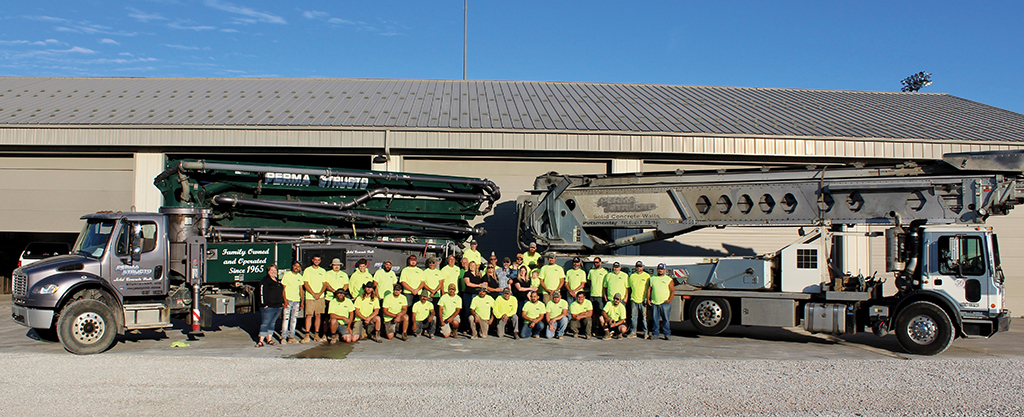
Among the longest standing recognitions maintained by the Concrete Foundations Association is the Contractor of the Year, which recognizes someone who has been attentive to the mission and vision of the association in regards to the membership class for which the CFA (originally the Poured Concrete Wall Contractors Association of America) was formed. Contractors are evaluated for their various commitments to networking, resources, leadership, industry development, and other facets to identify the spirit of the association at work.
Perma-Structo Inc. of Sturtevant, Wisconsin, was recognized during this year’s Concrete Foundations Convention, #CFACON21. Like their peers, the company endured one of the most challenging years in industry history. Owners, Mark and Patti Beaudin, showed a renewed commitment to leveraging their membership and honoring the legacy as a founding member through Patti’s father, Buck Sweet. Prior to the start of the pandemic, Perma-Structo invested in their workforce by contracting for construction education through the CFA. An entire morning, complete with a concluding lunch, was committed to foundation education and certification training conducted by Executive Director Baty. This education was part of a state-wide effort to increase awareness of the ACI 332 code document adopted by the State of Wisconsin as the prescriptive residential concrete code.
“Receiving the Contractor of the Year award is quite special. It’s really humbling to be recognized by the association and reassuring that the legacy and commitment of our company is now generational,” said Mark and Patti Beaudin, owners of Perma-Structo. “We are proud to be a founding member of the association and we look forward to continuing the legacy of our founder, Erwin (Buck) Sweet. Buck had the vision for our company years ago, and we hope to be as inspirational to future generations as he was to ours. We are thankful for the vision, time, and efforts put forth by the founding members in establishing the association. Receiving this award, which is the epitome of the founders’ objectives, is extremely rewarding.”
Perma-Structo demonstrated further influence in and care for the association network through consistent participation in the CFA Hotline. They used it as a way of getting at strategic areas of interest or challenge and found sources for available inventory of outdated and proven technologies. Third-generation leader, Cole Beaudin, challenged the company even further, sitting for and passing the ACI Certified Foundation Technician exam during Foundations Academy. During a year when participation in association networking was considerably challenging, Perma-Structo advanced their company while supporting the association and their colleagues.
With two generations of Beaudins now in leadership, the family was asked what the future holds. “We peaked and hit our best, but now we must decide how to continue that growth and progress,” the Beaudins said. “Winning a prestigious award like this is incredible, but it can also be dangerous. When you win, it can create this culture of complacency and stagnation. No one wants to mess with the status quo because it still works. But that doesn’t mean there isn’t room for improvement. Our focus for the future remains on continuing the education of our employees and our participation in local and national building associations. Striving to be great is not a part-time adventure.”
“One of the overlooked aspects of the association network is the multi-generational companies and the sustained leadership they evidence,” sad Jim Baty, the CFA executive director. “The Perma-Structo example this year challenges the association to maintain a wealth of resources and a variety of ways companies can grow, no matter the environment.”
Want to know more about the ways these companies benefitted the association over the past year? Do you have a story to tell or someone to nominate? Reach out to the staff at the Concrete Foundations Association by contacting our head of member engagement, Skye Kelley, at 319-895-6940 or skelley@cfaconcretepros.org.
Cyberattacks Have Increased More Than 600% Since the Start of the Pandemic

The Small Business Association advises small businesses to be aware of the most common types of cyberattacks, shown below:
Malware is software designed to damage your computer, server, client, or computer network.
A virus is a kind of malware that inserts a self-replicating code into your computer with the intention of giving cybercriminals access to systems on your computer.
Ransomware is a kind of malware that restricts access to your computer or threatens to publish some of your personal data unless a ransom is paid.
Phishing is a tactic designed to deceive you into clicking or interacting with a program that will infect your machine with malware or collect your sensitive information.
The past year has shown that cyber risk is increasingly impacting organizations of all sizes, yet many organizations remain unprepared. As cyberattacks increase in frequency and severity, it is more important than ever for companies to take time to understand their cyber risks and have defenses in place to recover from any attacks.
The SBA also suggests best practices for prevention, outlined below.
Train your employees on the following, as 60% of cyberattack claims are enabled by human error:
- Spotting a phishing email
- Using good browsing practices
- Avoiding suspicious downloads
- Creating strong passwords
- Protecting sensitive customer and vendor information
- Maintaining good cyber hygiene
Use antivirus software and keep it updated. Make sure each of your business’s computers is equipped with antivirus software and antispyware and is updated regularly.
Use strong passwords with:
- 10 characters or more
- At least one uppercase letter
- At least one lowercase letter
- At least one number
- At least one special character
- Multifactor authentication (which requires additional information to log in, e.g., a security code sent to your phone)
The insurance industry is uniquely positioned to fight cybercrime. Insurers have something that others (including most cybersecurity companies) do not: direct financial incentive to protect insured clients and prevent financial loss. Some carriers are willing to provide a cyber assessment for free, including recommendations to increase your cyber risk profile.
We encourage you to understand your risk, implement controls to protect your organization from being a target, and procure cyber insurance.
Please contact Mike Piechnik (Mike.piechnik@pelnik.com) or Ben Baker (Ben.baker@pelnik.com) at Pelnik Insurance for a cyber liability quote or more information.
Driving CFA Member Benefits: Perks Marketplace
Every association has the goal of developing opportunities that make sure its member companies benefit from membership. As an organization grows, variety begins to define it more than any other aspect. That variety is produced by company sizes, locations, demographics, interests, services and much more. Most companies joining the Concrete Foundations Association find the two primary benefits of membership to be networking and advocacy. For some, however, the instances of engagement with these two benefits can be distanced apart, making it difficult to recall them. This is why tangible benefits, or program-based opportunities, have a significant role — they continue offering value to members.
The “value proposition” of an organization is its leading purpose. It is defined as “an innovation, service, or feature intended to make a company or product attractive to customers” (OxfordLanguages, 2021). Since the Great Recession of 2008-10, the CFA has been committed to expanding resources and services principally geared toward the concrete contracting businesses that aspire to be called #CFAConcretePros. The latest efforts by the CFA’s board of directors began in the fall of 2020 with an extensive strategic planning event. The board gathered virtually with members who desired to help identify ways of furthering the association’s impact on member businesses and increasing the association’s attractiveness to the vast landscape of cast-in-place concrete contracting businesses.
Even before this renewed commitment to expanding resources and challenging member companies, the CFA leadership had entered into a relationship with Business AdvantEDGE in order to deliver a program titled “Savings4Members,” a business affinity discount-buying program. Through a members-only portal, this program introduced companies to the buying leverage they can gain by being part of a national association network. Today, that program is known as Perks Marketplace and is now a collaboration of Advanceα and Business AdvantEDGE. With a quicker and easier participant interface, the program is designed to give participating association networks access to a greater number of national and regional corporate partners.
So how does it work? A member organization creates a Perks Marketplace account through the program link provided by the CFA. Next, the member selects from 18 companies based on which buying opportunities and programs of interest appeal to them. The member account is verified with CFA membership privileges. Finally, the information about your purchase — which may consist of an online code, a subscription-based program, or an account card (i.e., fuel account) — is stored in your Perks account. It is that easy, and the value is exceptional.
Here is an example: A CFA member, Company A, creates a Perks Marketplace account and chooses Exxon Mobil for fuel purchases in Q2. A total of $27,200 is spent during that quarter. The member saved $1,088 (8¢ per gallon) in fuel rebates during the quarter. Annual membership for the CFA is $950. Therefore, Company A pays for the year of membership and, with three more quarters in the Exxon program, they can save an additional $3,000. This extra sum can be put toward Convention registration and travel expenses through their Perks Marketplace account.
CFA members can log in to their account profiles (found at www.cfaconcretepros.org) and find the portal to Perks Marketplace from the welcome screen.
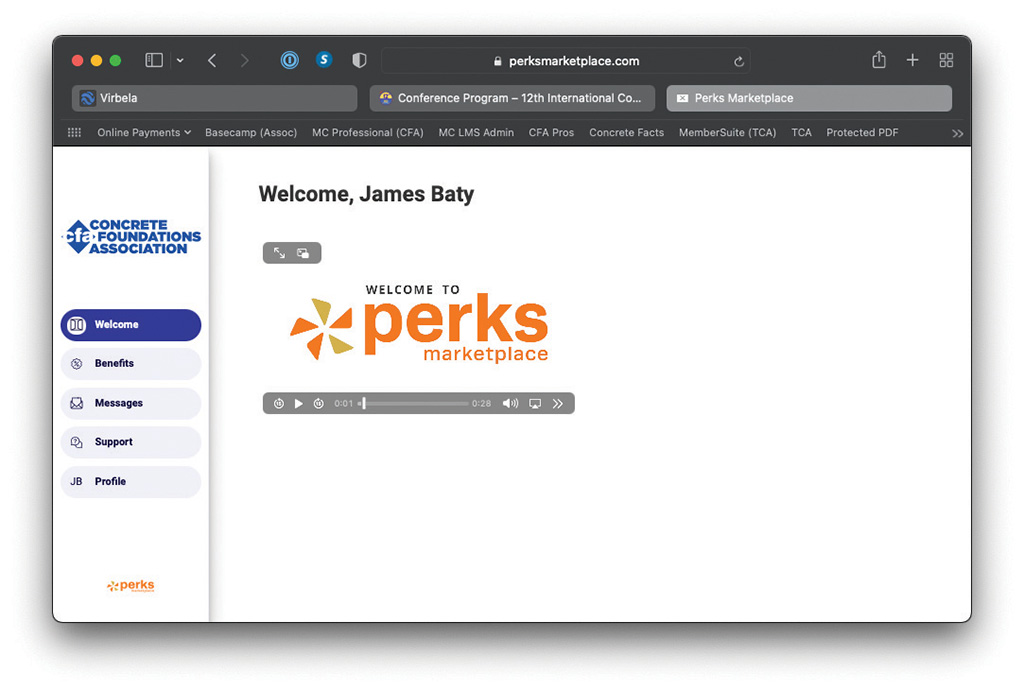
Accessing Perks Marketplace is a point-and-click interaction that opens a browser window. In that window you can register for a new account or bookmark the page and return each time a new account is of interest (which also entails entering your Perks Marketplace information).

“Membership has its privileges.” Can you name that slogan advertiser from a couple decades ago? The CFA is working to build reliable membership privileges for you, privileges and benefits and opportunities that contribute to immediate and quantifiable savings. These benefits complement and, in a sense, set the stage for the even greater business advantages found in thought-leadership networking and technical advocacy, which save members tens of thousands of dollars every year. Want to know more? Give it a try. See the special opportunity created in Perks Marketplace for CFA members with the CINTAS workday advantage program.
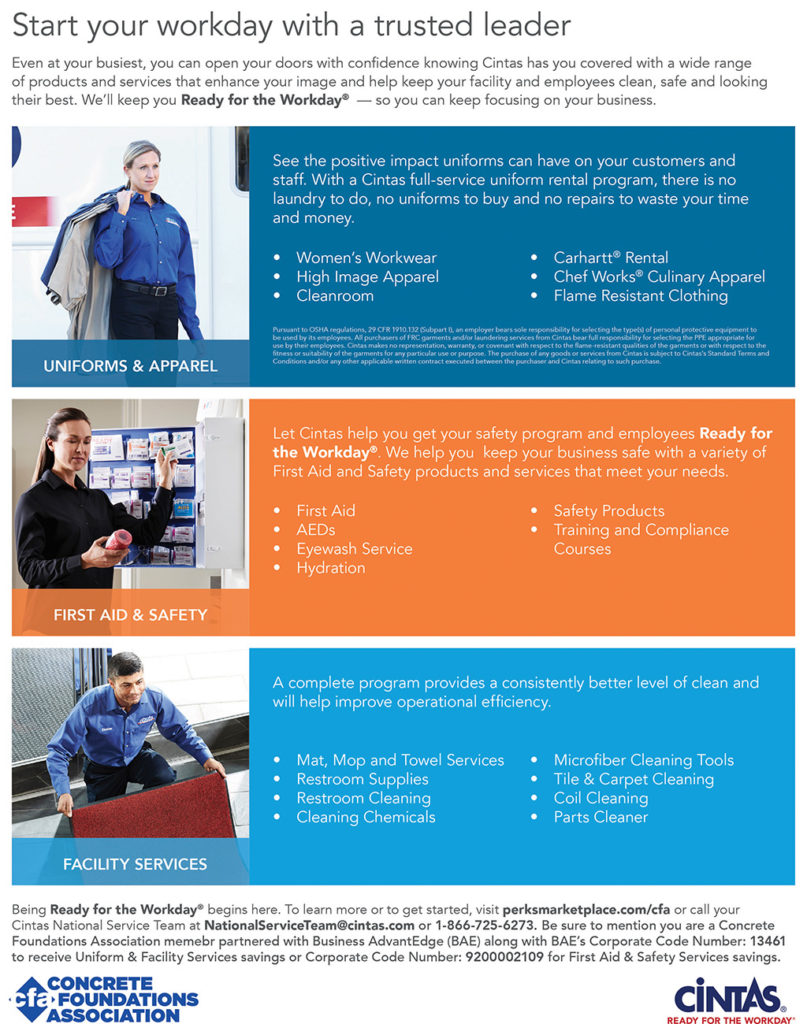
Build Confidence by Building Up Your Team
Take a moment to read the article in this issue of Concrete Facts about this year’s recipients of the CFA’s professional awards. As the executive director, it brings me great pride and joy to continue seeing the variety of individuals and companies who provide thought leadership, issue challenges, and roll up their sleeves to drive us forward. I have the pleasure of working under the direction of a tremendous board of directors, a team comprised of people who are as passionate about the businesses of you, the readers, as they are about their very own. This is the same feeling I get time and time again as I travel the country and am given opportunities to engage in advocacy and provide technical guidance.
Having had the fortune of sitting down with numerous great leaders this summer at #CFACON21, the Concrete Foundations Convention, I can’t help but feel we have begun to embrace the next decade of opportunity. Are we still facing a form-tie shortage? Yes. Are we still losing the labor battle or, at least, finding the effort to be ten times harder than ever before to find quality workers? Yes. Still, the contractors who drive this industry are the ones contributing to this Association and evidencing the cultural shift that must take place to make this specific workforce segment attractive.
What distinguishes companies today is not the volume of their work projects, the number of awards they win, or the number of crews they manage. Where I see companies setting the new standard is in their workforce investments. Empowering tomorrow’s leaders by making them today’s learners is currently the most important step a construction company can make. This must begin with the company’s owners and leaders. It may not be possible for us all to travel to a resort for three days of learning, but we have seen how a network can be extremely effective when it leverages the accessibility of a digital framework, virtual meetings, and teleconferences. Ultimately, of course, these virtual efforts will lead back to the preferred and advantageous format of in-person engagement, and this is where investing in your crews comes in.
Perma-Structo and Hottmann Construction both won awards this year, and they were recognized for their commitment to their workforce. They are examples of companies that, in the past year or so, have stepped outside of their comfort zones to respond to their realization that challenging their workforce’s intellect is the best way to engage their passion for work. Education is your most powerful tool to build up your team. Investing in educating the leadership and employees will lead to building out your capabilities and building confidence in your future.
Our mission and vision remains clear: to build the CFA into the strongest representative and advocate for the residential contractor while maintaining a vibrant network for collaboration and resources to challenge companies to develop in the directions they desire. Congratulations to this year’s winning organizations who are setting the pace for tomorrow.
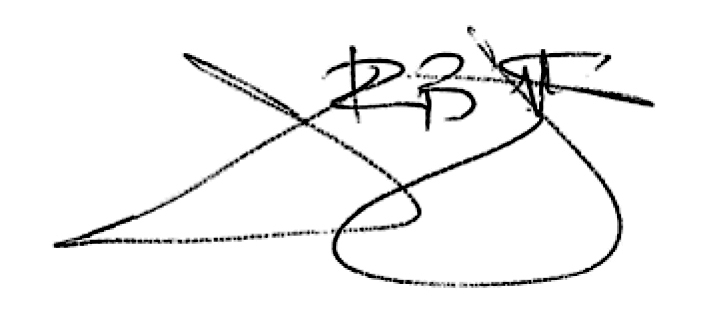
Improving Membership for You
The Concrete Foundations Association continues to make progress on efforts to help our members improve their businesses.
Late last year, over the course of several meetings, the board of directors created a strategic plan for the future of our association. We identified five key areas to focus on that would help our members and the industry.
From each of those five key areas, several initiatives were detailed. Each initiative will help our members in some way.
However, due to the time constraints of the board and CFA staff, not all initiatives can be done at the same time. So, we singled out the top six initiatives to tackle first. Those initiatives are:
1. Assess our membership dues structure to ensure we have the ability to provide valuable services to our members.
2. Hire a staff person to improve member engagement and increase membership.
3. Create training and instructional videos that members can watch for skill building and training.
4. Develop a directory so members can find companies of a similar size and specialization to their own company.
5. Create networking groups where members can interact to see what’s working in each other’s businesses.
6. Publish a telephone network guide so members can find and contact other members who could help them with specific issues they are having.
We have already implemented the first two initiatives. The membership dues were analyzed and increased. This increase allowed us to hire a staff person devoted to adding and retaining members. Her name is Skye Kelley, and she is already doing a terrific job.
For the rest of this year, we will focus on implementing the other four initiatives. Once those are completed, we will tackle additional initiatives that will benefit our members and improve our association.
If you are a CFA member, be on the lookout for more services and additional networking opportunities designed to help your foundation business.
If you are not yet a CFA member, now is a great time to invest in yourself and your company. You will get access to valuable resources and connect with other concrete contractors who have likely seen and solved some of your current problems. The rewards of membership will pay off your investment many times over.
I hope you all have a wonderful fall. I look forward to seeing many of you early next year in Las Vegas at the World of Concrete.

Doug Herbert, CFA President

